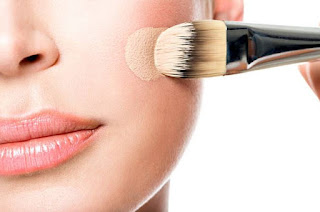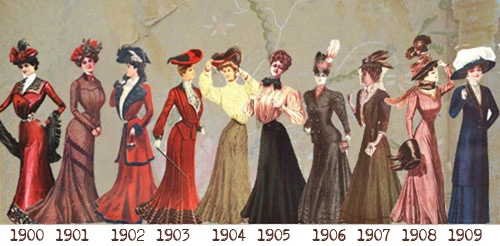A close inspection of fashion reveals some true highlights. These moments have had an enduring effect on people all over the world. Era by era, each period in the fashion timeline has its share of unforgettable moments.
1860s fashion in European and European-influenced clothing is characterized by extremely full-skirted women's fashions relying on crinolines and hoops and the emergence of "alternative fashions" under the influence of the Artistic Dress movement. In men's fashion, the three-piece ditto suit of sack coat, waistcoat, and trousers in the same fabric emerged as a novelty.
1870s fashion with the advent of the sewing machine came more creative innovations. Synthetic dyes made it possible to color clothing in vivid hues. Couture also played a stronger role in designs of this era.
Fashion in the 1880s in Western and Western-influenced countries is characterized by the return of the bustle. The long, lean line of the1870s was replaced by a full, curvy silhouette with gradually widening shoulders. Fashionable waists were low and tiny below a full, low bust supported by a corset. The Rational Dress Society was founded in 1881 in reaction to the extremes of fashionable corsetry.
Fashion in the 1890s in European and European-influenced countries is characterized by long elegant lines, tall collars, and the rise of sportswear. It was an era of great dress reforms led by the invention of the drop-frame safety bicycle, which allowed women the opportunity to ride bicycles more comfortably, and therefore, created the need for appropriate clothing.
Fashion in the period 1900–1909 in the Western world continued the long elegant lines of the 1890s. Tall, stiff collars characterize the period, as do women's broad hats and full "Gibson Girl" hairstyles. A new, columnar silhouette introduced by the couturiers of Paris late in the decade signaled the approaching abandonment of the corset as an indispensable garment of fashionable women.

Fashion from 1910–1919 in the Western world was characterized by a rich and exotic opulence in the first half of the decade in contrast with the somber practicality of garments worn during the Great War. Men's trousers were worn cuffed to ankle-length and creased. Skirts rose from floor length to well above the ankle, women began to bob their hair, and the stage was set for the radical new fashions associated with the Jazz Age of the 1920s.
The 1920s is the decade in which fashion entered the modern era. It was the decade in which women began to wear more comfortable clothes (such as short skirts or trousers). Men also began to wear athletic clothing for the first time. The suits men wear today are still based, for the most part, on those worn in the late 1920s. In the early part of the decade, change was slow, as many were reluctant to adopt new styles. From 1925, the public passionately embraced the styles associated with the Roaring Twenties.



The most characteristic North American fashion trend from the 1930s to the end of World War II was attention at the shoulder, with butterfly sleeves and banjo sleeves, and exaggerated shoulder pads for both men and women by the 1940s. The period also saw the first widespread use of man-made fibers, especially rayon for dresses and viscose for linings and lingerie, and synthetic nylon stockings. The zipper became widely used. These essentially U.S. developments were echoed, in varying degrees, in Britain and Europe.



1945-1960s Fashion in the years following World War II is characterized by the resurgence of haute couture after the austerity of the war years. Square shoulders and short skirts were replaced by the soft femininity of Christian Dior's "New Look" silhouette, with its sweeping longer skirts, fitted waist, and rounded shoulders, which in turn gave way to an unfitted, structural look in the later 1950s. Innovations in textile technology following the war resulted in new fabrics such as spandex, volleyball shorts and easy-care fabric finishes that fitted the suburban lifestyle of the 1950s with its emphasis on casual sportswear for both men and women. For the first time, teenagers became a force in fashion.




Fashion in the 1970s began with a continuation of the mini skirts, bell-bottoms, and the androgynous hippie look from the late 1960s and eventually became an iconic decade for fashion. Generally the most famous silhouette of the mid and late 1970s for both genders was that of tight on top and loose on bottom. The 1970s also saw the birth of the indifferent, anti-conformist casual chic approach to fashion, which consisted of sweaters, T-shirts, jeans, and sneakers.

1980s fashion in Britain, America, Europe and Australasia had heavy emphasis on expensive clothes and fashion accessories. Apparel tended to be very bright and vivid in appearance. Women expressed an image of wealth and success through shiny costume jewelry, such as large faux-gold earrings, pearl necklaces, and clothing covered with sequins and diamonds. Punk fashion began as a reaction against both the hippie movement of the past decades and the materialist values of the current decade. The first half of the decade was relatively tame in comparison to the second half, which is when the iconic 1980s color scheme had come into popularity.
In the early 1990s,several late 1980s fashions remained very stylish among both sexes. However, the popularity of grunge and alternative rock music helped bring the simple, unkempt grunge look into the mainstream by 1994. The anti-conformist approach to fashion lead to the popularisation of the casual chic look; this included T-shirts, jeans, hoodies, and trainers, a trend which continued into the 2000s (decade). Additionally, fashion trends throughout the decade recycled styles from previous decades, notably the 1950s, 1960s and 1970s.
The 2000s fashion are often described as being a "mash-up", where trends saw the fusion of previous styles, global and ethnic clothing (e.g. boho), as well as the fashions of numerous music-based subcultures. Hip-hop fashion generally was the most popular among young people, followed by the unisex indie look later in the decade. Those 25 years of age and older adopted a dressy casual style which was popular throughout the decade. Globalization also influenced the decade's clothing trends, with the incorporation of Middle Eastern and Asian dress into mainstream European, American and Australasian fashion. Furthermore, eco-friendly and ethical clothing, such as recycled fashions and fake fur, were prominent in the decade. In the early 2000s, many mid and late 1990s fashions remained fashionable around the globe, while simultaneously introducing newer trends. Although the 2000s did not have one particular style, they revived clothes primarily from the 1960s, 1970s, and 1980s.




The 2010s have thus far been defined by a revival of austerity era period pieces, hipster fashion, 1980s neon colors, and from late 2012 to 2016, unisex early 1990s styles influenced by grunge and skater fashions. In the early 2010s, many mid and late 2000s fashions remained popular in Europe, the United States, Latin America, Australasia and East Asia, especially the indie pop look which largely drew upon elements of 1970s garage rock, the 1960s counterculture, and contemporary alternative fashion.





































